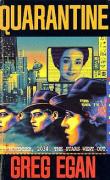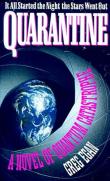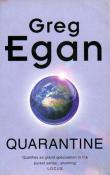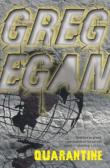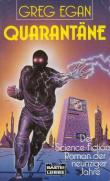AustLit
The material on this page is available to AustLit subscribers. If you are a subscriber or are from a subscribing organisation, please log in to gain full access. To explore options for subscribing to this unique teaching, research, and publishing resource for Australian culture and storytelling, please contact us or find out more.
Latest Issues
AbstractHistoryArchive Description
'It's late in the 21st century and bioengineering is now so common that people are able to modify their minds in any way they wish. It is an era which has been shaped by information systems so vast that security, in any form, is easily breached. Now, you can be whatever you want to be, and do whatever you want to do. On Earth anyway. One night, thirty three years ago, the stars went out. 'The Bubble' - a perfect sphere centred on the sun - appeared in the sky, isolating the solar system from the rest of the universe. For thirty-three years, humanity has lived with the religious cults and terrorism which spawned in the wake of the darkness. We are now alone. Humanity has been cut off: quarantined.'
Source: Publisher's blurb.
Publication Details of Only Known VersionEarliest 2 Known Versions of
Other Formats
- Also sound recording.
Works about this Work
-
Greg Egan's Quarantine and Teranesia : Contributions to the Millennial Reassessment of Consciousness and the Cognitive Nonconscious
2015
single work
criticism
— Appears in: Science Fiction Studies , 31 March vol. 42 no. 1 2015; (p. 56-77) 'The broader landscape in which Greg Egan's two symmetrically themed novels, Quarantine and Teranesia, unfold includes new research in neuroscience on the cognitive nonconscious (or proto-self) in humans. The cognitive nonconscious, which emerges from underlying neuronal processes, interacts with consciousness and the unconscious through its superior information-processing abilities. Egan links this new research with von Neumann's suggestion in the 1950s that the “wave collapse” in quantum mechanics, in which the superposition of particles creates indeterminacies through the particle's eigenstates, “collapses” so that, upon measurement, only one value is observed. While Quarantine explores the ways in which human consciousness is complicated by its interaction with quantum processes, Teranesia, in remarkable symmetry, investigates the possibility that the cognitive nonconscious may also emerge from and interact with quantum processes. Thus Egan plays with realigning into different configurations the three categories of consciousness/unconsciousness, the cognitive nonconscious, and material processes. As a result, the two novels constitute an important contribution to the millennial reassessment of the costs of consciousness and the rise of the cognitive nonconscious, serving as narratives to think with and through the recursive paradoxes and conceptual complexities inherent in this paradigm shift.' (Publication abstract) -
Geopolitics in Greg Egan's Science Fiction
2014
single work
criticism
— Appears in: Southerly , vol. 74 no. 1 2014; (p. 186-198) -
The Fiction of the Future : Australian Science Fiction
2012
single work
criticism
— Appears in: Sold by the Millions : Australia's Bestsellers 2012; (p. 128-140) 'According to Russell Blackford 'commercial science fiction is the most international of literary forms.' He observes that 'Australian SF continues to flourish, even if it trails heroic fantasy in mass-market appeal.' Australian SF writers although published internationally, with a dedicated fan followings in USA, UK and Europe, were overlooked for a very long time by Australian multinational publishers. The international editions had to be imported and were then distributed in Australia (Congreve and Marquardt 8). Blackford in his chapter throws light on the history of Australian SF and observes how Australian SF writers, with their concern for the future, achieved a powerful synthesis in form and content. The progress of Australian SF, maturity of style in the work of younger writers, and massive worldwide sales make Blackford optimistic as he asserts that 'the best Australian writers in the genre will be prominent players on the world stage.' (Editor's foreword xii-xiii) -
Scanners
2010
single work
review
— Appears in: SF Commentary : The Independent Magazine About Science Fiction , August no. 80 2010; (p. 12-13)
— Review of Quarantine 1992 single work novel -
Untitled
2009
single work
review
— Appears in: Aurealis : Australian Fantasy & Science Fiction , no. 42 2009; (p. 134-137)
— Review of Incandescence 2008 single work novel ; Quarantine 1992 single work novel
-
Untitled
1993
single work
review
— Appears in: Science Fiction : A Review of Speculative Literature , vol. 12 no. 2 (Issue 35) 1993; (p. 22-24)
— Review of Quarantine 1992 single work novel -
The State of Quarantine
1993
single work
review
— Appears in: Eidolon : The Journal of Australian Science Fiction and Fantasy , Summer no. 11 1993; (p. 40-45)
— Review of Quarantine 1992 single work novel -
Scanners
2010
single work
review
— Appears in: SF Commentary : The Independent Magazine About Science Fiction , August no. 80 2010; (p. 12-13)
— Review of Quarantine 1992 single work novel -
Untitled
2009
single work
review
— Appears in: Aurealis : Australian Fantasy & Science Fiction , no. 42 2009; (p. 134-137)
— Review of Incandescence 2008 single work novel ; Quarantine 1992 single work novel -
A Ride on the Cosmic Roller-Coaster
1992
single work
review
— Appears in: The Weekend Australian , 19-20 December 1992; (p. rev 6)
— Review of Back Door Man 1992 single work novel ; Quarantine 1992 single work novel ; Intimate Armageddons 1992 anthology short story -
The Fiction of the Future : Australian Science Fiction
2012
single work
criticism
— Appears in: Sold by the Millions : Australia's Bestsellers 2012; (p. 128-140) 'According to Russell Blackford 'commercial science fiction is the most international of literary forms.' He observes that 'Australian SF continues to flourish, even if it trails heroic fantasy in mass-market appeal.' Australian SF writers although published internationally, with a dedicated fan followings in USA, UK and Europe, were overlooked for a very long time by Australian multinational publishers. The international editions had to be imported and were then distributed in Australia (Congreve and Marquardt 8). Blackford in his chapter throws light on the history of Australian SF and observes how Australian SF writers, with their concern for the future, achieved a powerful synthesis in form and content. The progress of Australian SF, maturity of style in the work of younger writers, and massive worldwide sales make Blackford optimistic as he asserts that 'the best Australian writers in the genre will be prominent players on the world stage.' (Editor's foreword xii-xiii) -
Looking Awry at Cyberpunk Through Antipodean Eyes: Reading Neal Stephenson and Greg Egan from the Margins
1998
single work
criticism
— Appears in: Australian Studies , Summer vol. 13 no. 1 1998; (p. 31-43) -
Tomorrow's Selfhood: Self in the Science Fiction of Greg Egan
1999
single work
criticism
— Appears in: The Fantastic Self : Essays on the Subject of the Self 1999; (p. 295-303) -
Geopolitics in Greg Egan's Science Fiction
2014
single work
criticism
— Appears in: Southerly , vol. 74 no. 1 2014; (p. 186-198) -
Greg Egan's Quarantine and Teranesia : Contributions to the Millennial Reassessment of Consciousness and the Cognitive Nonconscious
2015
single work
criticism
— Appears in: Science Fiction Studies , 31 March vol. 42 no. 1 2015; (p. 56-77) 'The broader landscape in which Greg Egan's two symmetrically themed novels, Quarantine and Teranesia, unfold includes new research in neuroscience on the cognitive nonconscious (or proto-self) in humans. The cognitive nonconscious, which emerges from underlying neuronal processes, interacts with consciousness and the unconscious through its superior information-processing abilities. Egan links this new research with von Neumann's suggestion in the 1950s that the “wave collapse” in quantum mechanics, in which the superposition of particles creates indeterminacies through the particle's eigenstates, “collapses” so that, upon measurement, only one value is observed. While Quarantine explores the ways in which human consciousness is complicated by its interaction with quantum processes, Teranesia, in remarkable symmetry, investigates the possibility that the cognitive nonconscious may also emerge from and interact with quantum processes. Thus Egan plays with realigning into different configurations the three categories of consciousness/unconsciousness, the cognitive nonconscious, and material processes. As a result, the two novels constitute an important contribution to the millennial reassessment of the costs of consciousness and the rise of the cognitive nonconscious, serving as narratives to think with and through the recursive paradoxes and conceptual complexities inherent in this paradigm shift.' (Publication abstract)
Awards
- 1993 winner Ditmar Awards — Best Novel
Last amended 31 Jul 2020 12:39:25
Settings:
- 2000-2099
Export this record

